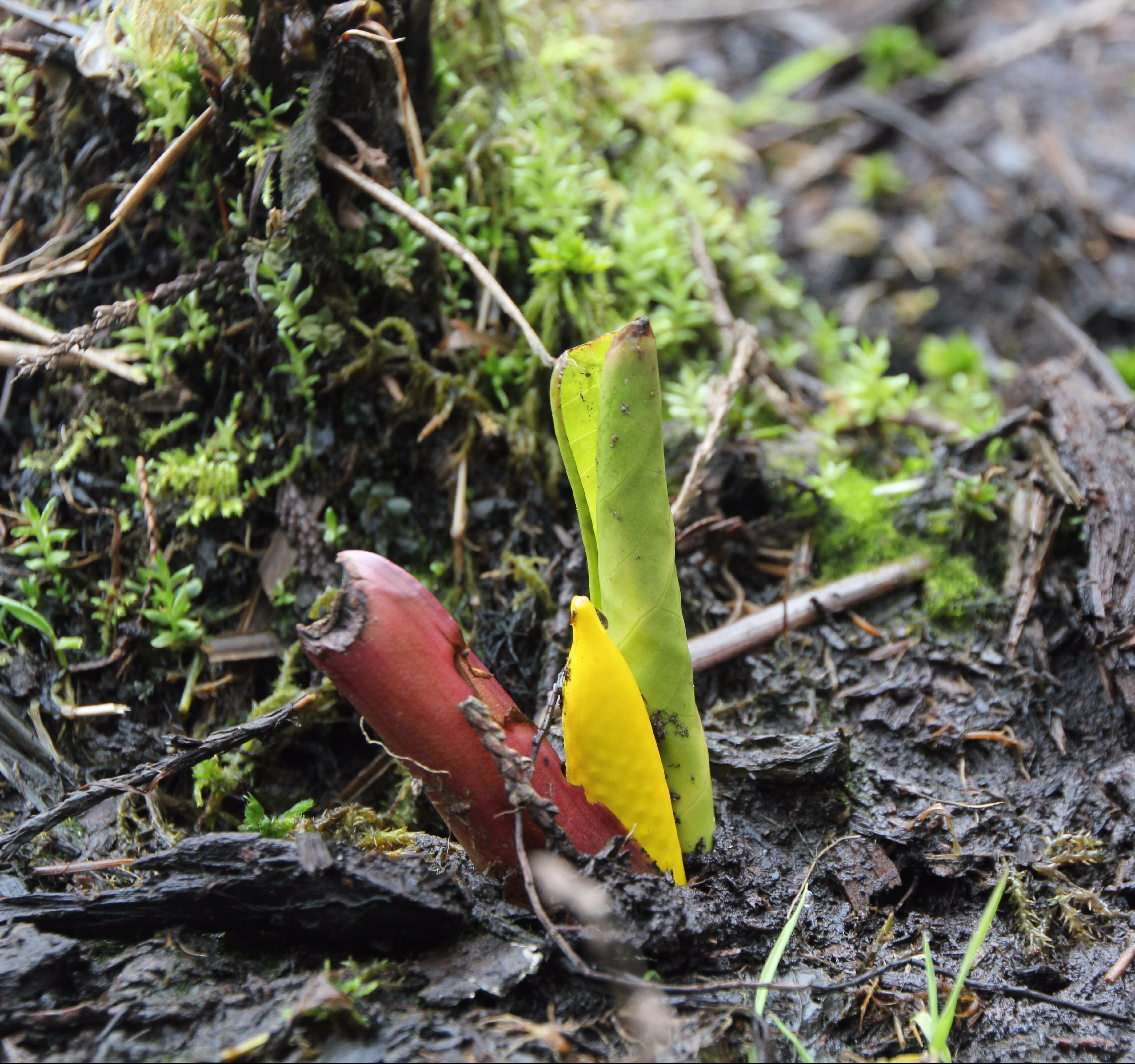‘In the ancient days they say there was no salmon. The Indians had nothing to eat save roots and leaves. Principle among there was the skunk cabbage.
Finally, the spring salmon came for the first time. As they passed up the river, a person stood upon the shore and shouted, “Here come our relatives whose bodies are full of eggs! If it had not been for me all the people would have starved.”
“Who speaks to us?” asked the salmon.
“Your uncle the Skunk Cabbage,” was the reply.
The salmon went ashore to see him, and as a reward for having fed the people, he (the Skunk Cabbage) was given an elk-skin blanket and a war club, and was set in the rich soft soil near the river.’
-Kathlamet story related to Haskins, 1934- Plants of the Pacific Northwest Coast, Pojar and Mackinnon, pp334.

The Kathlamet story of the origin of Lysichiton americanus is comprehensive. The tale describes the physical characteristics of this other wordly member of the arum plant family; the flowers are produced in a spadix contained within a 7–12 cm, large, bright yellow spathe atop a 30–50 cm stalk which much resembles a war club. And the Kathlamets also describe its distribution in soft, moist soil. Most importantly, it describes the skunk cabbage’s role in stemming famine as mammals, including humans, emerge from winter.
Source of food
Well noted for its other-worldly appearance, Lysichiton americanus, known by its common name, skunk cabbage. It has also been called the “swamp lantern”. The skunk cabbage is one of the earliest harbingers of spring.
Being an “early bird”, the skunk cabbage serves as an early food source to the Sitka black-tailed deer,emerging black bears, and returning geese. As related in the Kathlamet native story above, the skunk cabbage was also famine food for them and other early native communities. The deer after a bleak winter of bark and lichen will browse on the emerging flower buds and leaves. Seeing cropped emerging skunk cabbage plants is a certain sign of deer in the area. The hungry bears will dig up and devour rhizomes, flower, and leaves. According to Wikipedia
The plant was used by indigenous people … for food in times of famine, when almost all parts were eaten. The leaves have a somewhat spicy or peppery taste. Caution should be used in attempts to prepare western skunk cabbage for consumption, as it contains calcium oxalate crystals, which result in a gruesome prickling sensation on the tongue and throat and can result in intestinal irritation and even death if consumed in large quantities.

When we first came here, we would see skunk cabbage growing in Prince of Wales life enriched muskegs, near rivers, alongside lakes, and just about any damp spot of soil. Initially, I did not know the difference between a skunk cabbage patch visited by deer or bear. In fact, whenever I saw a patch of skunk cabbage that had been munched on, I would be alarmed and keeping an eye out for bear, vacating the immediate area, “just in case” being a cautious old soul. Than one day when the pups and I were hiking off a logging road and came upon a large patch of skunk cabbage that had been dug up, the earth torn up, rhizomes and flowers gone, leaves and short stalks torn and tossed about. And that is a patch of skunk cabbage visited by bears.

About Lysichiton americanus
Near the end of each Prince of Wales winter, the appearance of Lysichiton americanus was always a welcoming surprise to me. Where ever they emerge, their reddish brown bract encapsulating a yellow bud are in the middle of a small patch of moist brown earth surrounded by early spring snow . Unlike the genus Symplocarpus (which includes S. foetidus, the eastern skunk cabbage), the flowers of Lysichiton species do not produce heat, a commonly held belief that is incorrect. The Wikipedia article on the skunk cabbage states that this is disputed; not surprising as the flower of Lysichiton is often seated in a close circle of brown earth surrounded by several inches of snow.
Skunk cabbage flourish in damp areas near rivers, springs, lakes and other wetlands in Southeastern Alaska penninsula, and the Pacific Northwest. The plant grows from rhizomes deeply embedded in moist soil.
Other uses of the skunk cabbage in a follow-up blog…I had started this blog post much earlier, while we were enjoying spring and am just going to complete it next spring!

Leave a comment